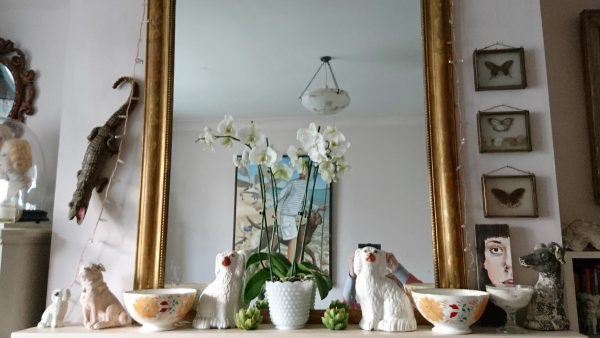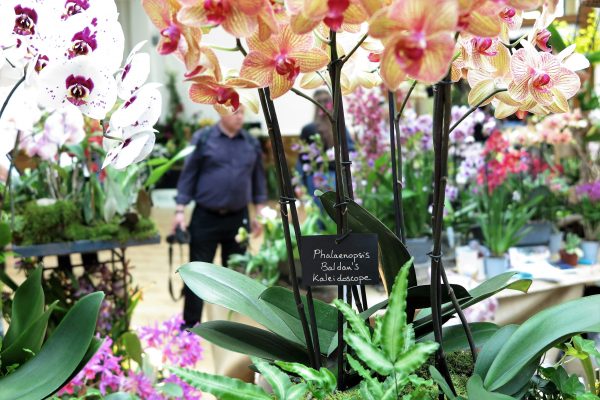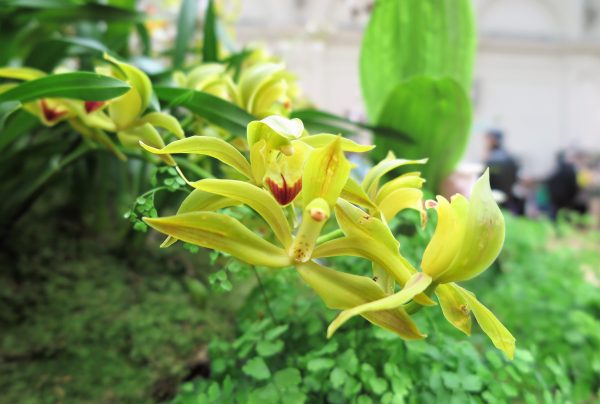Do you feel guilty about orchid care?
Have you been given a potted orchid which did look beautiful for weeks?
And do you now have a sad little transparent pot full of dried-up roots, with a stick poking out of it? Outside your back door or on your kitchen windowsill?
Not exactly thrown away, but not going anywhere either?
I thought so. Me too.

Phalaenopsis orchid ‘Vieux Rose’ from Vacherot & Lecoufle, France.
Orchids are the number one house plant purchased world wide. Many of those purchases are gifts.
But orchid care makes us feel guilty
We’ve all probably been given at least one phalaenopsis orchid at some point.

Phalaenopsis ‘Luxor’ – from Burnham Nurseries – almost outrageously beautiful.
The flowers last for weeks. And orchids thrive on neglect. You don’t need to water your orchids more than once a week, if that. I’ve often wondered if orchids I’ve been given were really alive because they stayed looking immaculate for so long.

This phalaenopsis orchid has been looking gorgeous for four months on a friend’s mantelpiece.
But how do you look after it? It’s not like an ordinary house plant, is it? Or is it?

I love the way Vacherot & Lecoufle have filled a big bowl with white orchids at the RHS Spring Plant and Orchid Show. It would be an easy trick to copy with orchids from the supermarket.
For some of us, our only contact with orchids is getting or giving white phalaenopsis orchids from the supermarket as gifts. Our definition of ‘orchid care’ is giving it the odd nervous watering.
At the other end of the spectrum are orchid-lovers who travel the world to see orchids in the wild. Orchids grow everywhere except Antartica, so they can justify going absolutely anywhere. Orchid fanatics often have greenhouses packed with orchids and know all about orchid care.
And there are 25,000-30,000 different varieties of orchid, so this isn’t a hobby where you ever get to the point where you’ve seen it all.
I decided to get a grip…
Baby Bio are sponsoring this post on orchids so that I could compare their new Baby Bio Orchid Feed & Mist with two competitor mists.
Most orchids don’t need much watering, but you should mist their leaves and any aerial roots regularly. A fine mist is important because the plant can rot if large drops of water get lodged in the crown.
So I decided that this was an ideal opportunity to stop feeling guilty about orchids. They are too beautiful.
I set off to the RHS Spring Plant and Orchid show to hear a talk from Sarah Rittershausen of Burnham Nurseries about Easy Growing Orchids in the Home.

The RHS Spring Plant & Orchid Show in London
Where to put your orchid
Orchids are easy to look after, but you do have to put them in the right place in your home.
Don’t panic. Yes, those 25,000+ varieties each come from a different climate. So, in theory, 25,000 different places in your home, according to each orchid’s nature.
But Sarah simplified it very clearly.

Cymbidium orchids live in the Himalayas, so they think year-round central heating is permanent summer. This stops their flowering cycle and encourages them to produce more leafy growth.
There are five or six types of orchid that we might buy or be given as a beginner. Two will do well in relatively cool houses. They won’t like being in a centrally heated room all year round. Three are ideal for centrally heated homes (although avoid placing an orchid on a sunny windowsill in summer).
The two orchids that like cool winters and moderate summers are ‘cool’ dendrobiums and cymbidium orchids.

A ‘cool’ dendrobium orchid from Burnham Nurseries. It has a thick cane stem with clusters of flowers coming directly off it. It needs to be cool-ish in the winter. That’s around 8-10 degrees C – for example, an unheated conservatory.
Words like ‘dendrobium’ and ‘cymbidium’ aren’t easy to remember (I find!). However, if you buy from a nursery, then you should be able to discuss your home and say where you want to put the orchid. The grower will then recommend suitable orchids. (Or pin this post if you use Pinterest, then you’ll be able to find it again when you need it.)

Cymbidium lowianum – an orchid that likes a cool room in winter, but can live on your terrace in moderate climates in summer.
Orchids for centrally heated homes
Phalaenopsis orchids are perfect for centrally heated homes, which is why we get given them as gifts. If you’re new to orchids, this is probably what you think of as ‘an orchid.’

Phalaenopsis orchid ‘Baldan’s Kaleidoscope’ from Vacherot & Lecoufle
Phaleonopsis orchids don’t like their environment to get any cooler than 15-18 degrees centigrade at night. That’s just about right for most homes.
You can find out more about how to choose and look after phalaenopsis orchids on the website LoveOrchids.co.uk. There is style inspiration, too and other info.

Phalaenopsis orchids from DoubleH Orchids who support LoveOrchids.co.uk
It has lots of fascinating facts and tips, including the warning that you shouldn’t place your orchid too near a bowl of ripening fruit.
Ripening fruit gives off ehtylene gas, which may cause your orchid to drop its flowers. So if your orchid died, maybe that’s the reason.
On the whole, though orchid flowers seem incredibly long-lived.
Other ‘beginner’ orchids include Slipper Orchids (Paphilopedilum) and ‘warm’ Dendrobiums.

Paphilopedilum or Slipper orchids Pinocchio (left) and St Swithin (right).
There is so much variety just within these three orchid types, so you have a lot of choice. They like being in light, warm rooms, but avoid strong sunlight in the summer. So you can put an orchid on a south-facing windowsill in winter, but not in summer.
Orchid care – feeding and watering
Orchids don’t need much food and water, said Sarah. But they will flower better if you feed them. Many of them cling to trees in the wild, or grow in rocky places. They learn to survive on very little.
The reason why you need to use specialist orchid feed solutions and special orchid compost is that ordinary plant feeds and composts will be too rich for orchids. A specially-formulated orchid feed, such as Baby Bio Orchid Feed & Mist, has the right amount of nutrients to help your orchid flower for as long as possible.
Most importantly, they often grow in humid environments. Many are tropical or semi-tropical, so our homes aren’t humid enough for them.
This is a short video on orchid care:
Sarah says that you should spray the leaves of your orchid 2-3 times a week, or even every day. Avoid spraying the flowers. And don’t let water collect in the crown of the plant.

Baby Bio Orchid Feed & Mist ready for action on my mantelpiece.
You can just spray water. However, if your water is hard, Sarah said it’s better either to buy a special mister, or buy spring water.
Baby Bio Orchid Feed & Mist comparative test
Baby Bio asked me to test their Orchid Feed & Mist against two competitor orchid mist sprays.
I added an equal amount of food colouring to all three sprays. Then I sprayed three pieces of plain white paper with Spray A, Spray B and Spray C.
Baby Bio asked me to make sure that I sprayed each piece of paper for just one second. I also needed to make sure that I sprayed from 50cms away each time.

The Baby Bio Orchid Feed & Mist is so fine that you can barely see it on the paper. But I did spray exactly the same amount, and it had just as strong a dye!
The mist from Spray A was so fine, it barely marked the paper. There were a quite large spots with Spray B. Spray C was more even, but had several bigger spots.
Spray A was the Baby Bio Orchid Feed & Mist.
Baby Bio didn’t ask me to comment on the spray mechanism itself. However, it’s worth saying that I found the Baby Bio spray significantly easier to use. It was just a quick squirt. I had to fiddle around with the other two, and they felt clunkier to use.
How to water your orchid
Sarah emphasises that ‘less is more’ when it comes to watering most orchids.
Many orchids are now sold in transparent plastic pots. This isn’t because orchid roots need light. It’s to help you see when the orchid need watering.
Green roots mean the orchids have enough water. Silvery-grey roots mean they’re probably about ready to be watered again. Brown roots mean that you’ve over-watered and the roots are rotting.
She also suggests you get used to the weight of your orchid pot. If it’s relatively heavy, it’s well watered. Once it feels light, you need to water again.
You should never water your orchid more than once a week, says Sarah. Once a fortnight might be better. She has even left some orchids for 3-4 weeks before watering them again.

You can use attractive containers for orchids. But make sure they’re still in their original pots with drainage holes so you can lift them out of their ceramic pots to water and drain properly.
Orchid pots must have drainage. Stand your orchid in the sink and give it a good soaking for a few minutes. Then let it drain thoroughly before returning it to its outer pot or trough.

Stand your orchids in the sink to drain after watering. Orchids from DoubleH orchid growers.
How to feed your orchid
Orchid care means giving it some extra nutrition, but not much. Use a specialist orchid food and follow the instructions. Don’t over-do it or you’ll get lots of leaves and no flowers.
Use a specialist orchid compost when re-potting. Ordinary garden compost will be too rich, and won’t drain well enough.
I’ll be using the Baby Bio Orchid Feed & Mist on my orchids, as it seems the easiest way to give them a balanced amount of nutrients.
When should you re-pot your orchid?
One of the audience at the RHS Orchid show asked Sarah of Burnham Nurseries how often she should re-port her orchid. ‘It hasn’t flowered for three years.’
Sarah asked how long it had been in the pot. ‘Fifteen years’ was the answer.
‘I think it might be due for re-potting,’ she said, with admirable restraint.
The fact that an orchid can flower for 12 years without being re-potted is an extreme example of how hardy orchids are about somewhat bleak growing conditions.
LoveOrchids recommends re-potting phalaenopsis orchids every 4-5 years ‘or when the orchid is practically jumping out of the pot.’
Use bark or specialist orchid compost because ordinary potting compost doesn’t drain well enough for orchids.
Orchid care when flowering is over
Cut off any brown roots or stems. If your orchid is a ‘cool’ dendrobium it will have a thick cane stem where it stores nutrition so don’t cut this down unless it’s obviously dead.
Loveorchids.co.uk warns against cutting the whole stem down on phalaenopsis orchids. You’ll get bigger flowers if you do, but they’ll take longer to come. ‘Cut just above a node that is below any previous branch or bloom.’
Move the orchid to somewhere cooler (no lower than 17 degrees for phalaenopsis, says Loveorchids.co.uk).
However, don’t put it in a dark corner – it will still want light.
Carry on with watering every week or so, and spraying the leaves and aerial roots 2-3 times every week. And the flowers should be back again.
I feel I understand orchids much better now. They really do seem to offer so much, and ask for so little in return.
Pin this post to refer to it later
The post Orchid care – how to stop feeling guilty and love your orchid appeared first on The Middle-Sized Garden.
from The Middle-Sized Garden http://www.themiddlesizedgarden.co.uk/orchid-care-stop-feeling-guilty-love-orchid/

No comments:
Post a Comment